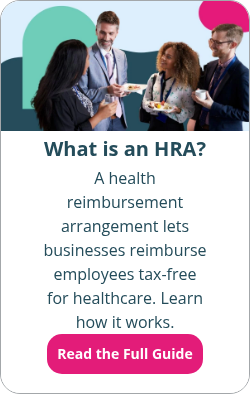What is healthcare reimbursement?
By Elizabeth Walker on February 24, 2025 at 8:30 AM
As an employer, you know that offering health benefits is key to attracting and retaining top employees. But, traditional group health insurance can be expensive, complex, and limiting for many small businesses with limited resources. Thankfully, you have other options. Instead of administering a group policy, you can reimburse your employees for their individual medical coverage and costs.
A healthcare reimbursement plan is an employee benefit where employers reimburse their staff for qualifying medical expenses. Instead of choosing and offering one policy to an entire group of employees, the employer gives employees a monetary allowance to buy the health insurance policy of their choice.
Curious about how this process works? We’ll explain everything you need to know.
In this blog post, you'll learn:
- How healthcare reimbursement plans work as an affordable coverage option for employees.
- Why more employers are choosing reimbursement plans instead of traditional health coverage.
- Various healthcare reimbursement options like health reimbursement arrangements (HRAs) and health stipends.
What is a healthcare reimbursement?
Healthcare reimbursement plans are employer-funded health benefits. With this type of plan, employers can reimburse employees for insurance coverage and out-of-pocket healthcare costs, like prescription drugs.
A healthcare reimbursement benefit isn't a health insurance plan. Instead, employers provide their employees with an allowance to spend on medical care, including health insurance premiums.
The term “healthcare reimbursement plan” also describes a medical expense reimbursement plan (MERP). With both plans, employers offer employees a defined contribution toward healthcare costs and monthly premiums.
Why are healthcare reimbursement plans becoming popular?
Healthcare reimbursement plans are becoming more popular among employers. For instance, individual coverage HRA (ICHRA) adoption has increased by almost 350% since its introduction in 20201. This is in spite of the fact that overall health benefit offer rates have remained steady over the same time period2.
One reason for the increasing popularity of healthcare reimbursement plans is the rise in traditional group health plan costs. These increases can make group health plans unaffordable for many small- to medium-sized organizations. While some small employers may opt for high-deductible health plans (HDHPs) to lower premium costs, these policies leave employees with higher out-of-pocket expenses.
Health reimbursement plans give employers cost control and offer value to employees. With this type of plan, employers set a fixed allowance amount that they won’t exceed. Employees use this allowance to purchase an individual plan of their choosing. Because reimbursement plans offer employees choice, they can choose affordable coverage that includes their preferred healthcare providers.
Health reimbursement plans also allow employees to choose which qualifying healthcare expenses they request reimbursement for. This gives employees more freedom and flexibility than other health benefits.
How do healthcare reimbursement plans work?
First, employers establish their HRP. This includes setting custom monthly allowances and designing benefit rules.
Many healthcare reimbursement plans are formal arrangements subject to the Employee Retirement Income Security Act of 1974 (ERISA), which requires employers to have legal plan documents. You’ll need to establish these documents when you create your benefit.
Formal healthcare reimbursement plan documents must follow all applicable federal regulations and include the following:
- The plan’s coverage period
- Guidance on eligibility, including if part-time employees can participate
- How employees can use their unused funds and what expenses you can reimburse employees for during the coverage period
- How you approve reimbursements for out-of-pocket medical expenses
- How you distribute an employee’s tax-free reimbursements
- What happens in the event of a decision dispute
- COBRA continuation coverage requirements
Once the employer offers an employee the benefit, they can make eligible purchases and submit their medical expenses for reimbursement. Employers or third-party administrators (TPAs) approve or deny a reimbursement request based on the plan's specific rules and regulations. Once approved, employers reimburse employees up to their monthly allowance.
What can you use a healthcare reimbursement plan for?
Depending on the type of healthcare reimbursement you offer, your employees can use it for various out-of-pocket expenses.
If you offer a formal healthcare reimbursement plan such as a health reimbursement arrangement (HRA), you can only reimburse your employees for qualified medical expenses outlined in IRS Publication 5023 and the CARES Act4.
If you want to help employees cover a wider range of expenses, you can offer a taxable health stipend. There aren't any restrictions on eligible items and services with a stipend. So, they’re especially helpful if you want to help employees with mental health expenses, as an HRA only allows you to reimburse mental health-related costs if the employee has a diagnosed mental illness.
What are the different types of healthcare reimbursement plans?
Many types of reimbursement plans are available. We’ll explain each and present potential pros and cons for your business.
Health reimbursement arrangement (HRA)
HRAs are formal health benefits that allow you to reimburse your employees tax-free for qualifying medical costs, including individual health insurance premiums and other out-of-pocket expenses. Unlike flexible spending accounts (FSAs), you fund the HRA solely by employer contributions.
With an HRA, employers can set a monthly or annual allowance for employees to use on eligible healthcare expenses. After an employee makes a purchase and you approve it, you reimburse them tax-free up to their allowance amount. Any unused HRA funds stay with you at the plan year's end or if an employee leaves your organization.
One of the best features of an HRA is that reimbursements are tax-deductible and free of payroll taxes for employers. They’re also income-tax-free for employees.
Some of the most popular HRAs include:
- The individual coverage HRA (ICHRA). An ICHRA is one of the most flexible personalized health benefits. Employers can set different monthly allowances and determine eligibility based on classes of employees. You can also choose to reimburse employees for premiums only or premiums plus other out-of-pocket expenses. Organizations of all sizes can offer an ICHRA, and it has no contribution caps. If you plan to provide an ICHRA, you should send an HRA notice to all eligible employees at least 90 days before offering the benefit.
- Applicable large employers (ALEs) can also design an ICHRA to satisfy the Affordable Care Act’s (ACA) employer mandate.
- To take part in the benefit, employees must have qualifying individual health insurance plans.
- The qualified small employer HRA (QSEHRA). The QSEHRA is for organizations with fewer than 50 full-time equivalent employees (FTEs). Like the ICHRA, the QSEHRA allows you to reimburse employees for premiums only or premiums plus other out-of-pocket expenses. This type of HRA has annual maximum limits but no minimum limits. Full-time W-2 employees are automatically eligible for the benefit. But, you can extend the benefit to part-time employees as well.
- To participate, employees must have a health insurance plan with minimum essential coverage (MEC).
- The group coverage HRA (GCHRA). Also known as an integrated HRA, the GCHRA is only for employers who offer a traditional group health plan. With a GCHRA, you can reimburse your employees for qualified out-of-pocket medical costs their group health plan doesn’t cover or fully cover, such as deductibles and copays. However, premiums aren’t eligible for reimbursement. Only employees enrolled in your traditional group health plan can participate.
- The excepted benefit HRA (EBHRA). The EBRHA is similar to the GCHRA. It allows employers to reimburse employees for premiums for certain excepted benefits and other eligible out-of-pocket costs.
If your organization has fewer than 50 FTEs and you don't plan on offering traditional group health plan coverage, you can provide either a QSEHRA or ICHRA. But, a QSEHRA has an annual maximum limit. If you want to offer your employees a larger allowance, then an ICHRA might be better.
With a QSEHRA or an ICHRA, current employees can purchase individual health insurance coverage and out-of-pocket costs that work best with their preferred healthcare providers and services. You can then reimburse employees for their health insurance premiums.
Health stipends
You can also offer your employees a health stipend. A health stipend is an informal reimbursement benefit with fewer regulations and restrictions than an HRA.
Here’s how a health stipend works:
- Like an HRA, a health stipend allows you to set an allowance for your employees. This can be monthly, quarterly, or annual. Stipends have no annual contribution limits. So, you can choose any allowance amount.
- Employees can then choose their own health insurance policy with their preferred providers and healthcare systems. Then, employers can reimburse employees for their insurance premiums and other out-of-pocket expenses. Expense approval is up to the employer, so you can define what's reimbursable and what isn't.
- You can offer a stipend to any type of worker, including a 1099 contractor, international worker, or part-time employee. It can also support employees who receive federal advance premium tax credits. Unlike HRAs, workers can use their full health stipend allowance while remaining eligible for their credits.
However, this flexible benefit comes with a cost. Under IRS Publication 15-B5, you must report stipend amounts on your employees' W-2s as taxable income. It also doesn't satisfy the ACA's employer mandate for organizations with 50 or more FTEs. Lastly, you can’t ask for proof of health coverage or proof of purchase for items listed in IRS Publication 502.
How PeopleKeep and Remodel Health can help
The rules and regulations surrounding the healthcare industry can be tricky to navigate. Many employers look for alternatives to a traditional group health plan can be burdensome to manage due to working with a health insurer. But, healthcare reimbursement plans have their own challenges. If you need expert guidance while managing this type of benefit, PeopleKeep and Remodel Health can help.
PeopleKeep’s health benefits administration software allows small to mid-size employers to administer an ICHRA, QSEHRA, or health stipend to their employees in minutes, giving them more time to focus on running their company.
When you manage your health benefit through PeopleKeep, you’ll have access to an intuitive benefit design process, automatically generated plan documents, and claims documentation storage. Our team will also perform documentation reviews and provide support if you run into any challenges.
If you’re a large employer or broker looking for a more robust ICHRA solution, Remodel Health’s ICHRA+ solution can help. With ICHRA+, you’ll have a team that will guide you through the launch and implementation of your new benefit, including enrollment support for employees.
In addition to software that will help you manage claims and employee payroll, you’ll have access to dedicated support if you need support with the day-to-day management or overall strategy of your benefit.
Conclusion
You don't need to buy an expensive group plan to offer your employees a healthcare benefit. With a healthcare reimbursement benefit, like an HRA, your organization can provide a cost-effective alternative to a traditional group plan. These personalized, defined-contribution health benefits give your employees more control over their health insurance coverage, improving the quality of patient care and employee satisfaction.
Ready to offer an HRA to your team? Schedule a call with an HRA specialist now!
This blog article was originally published on February 10, 2014. It was last updated on February 24, 2025.
1. Growth Trends for ICHRA and QSEHRA
2. KFF Health Benefits Offer Rates
4. CARES Act
Check out more resources
See these related articles

Can I reimburse employees for health insurance?
Learn about the two most common ways to compliantly reimburse employees for their healthcare: taxable stipends and health reimbursement arrangements (HRA).

Health insurance reimbursements: What are the options?
Explore your options for health insurance reimbursement. Understand what insurance reimbursement means and how HRAs can support employees.

What are the common healthcare reimbursement models for small businesses?
Learn about the healthcare reimbursement models available for small businesses and find the best fit for your budget and employee needs.



